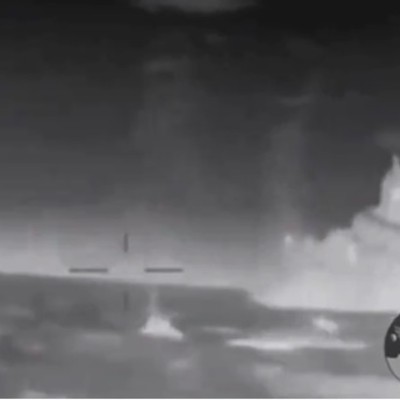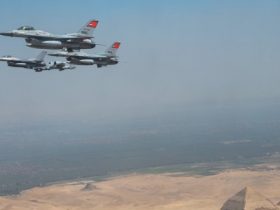Ukraine’s use of aerial drones and robot boats are hampering Russian naval operations in the Black Sea and rewriting the playbook for war planners concerned with maritime chokepoints.
The turn to uncrewed weapons was born of necessity. In 2014, Kyiv lost its its naval headquarters at Sevastopol and a good portion of its fleet to Russian annexation. Within weeks of Russia’s full-scale invasion in February 2022, the Ukrainian Navy was effectively out of commission.
But instead of ceding the maritime dimension of the conflict, Ukraine adapted, relying heavily on missiles and, increasingly, drones. Both the Navy and the MoD’s Main Directorate of Intelligence have employed a legion of uncrewed surface vessels (USVs) and uncrewed air vehicles (UAVs) to hit Russian targets, often pairing the drones with missiles to saturate Russian defenses around Crimea.
Ukraine helped usher in a new phase of asymmetrical warfare at sea with an October 2022 attack on Russia’s primary naval base in Sevastopol. Seven USVs and nine UAVs attacked the base, reportedly damaging Pr.22350 frigate Admiral Makarov and Pr.266 minesweeper Ivan Golubets. Neither vessel was destroyed, but the operation demonstrated how Ukraine could use the attritable systems to great effect – and at low cost.
Such combined drone attacks, once a novelty, have become commonplace. And though Russia has worked to improve its defenses against drone threats, a number of the Black Sea Fleet’s ships have fallen victim to Ukrainian strikes. On Feb. 14, Ukraine used MAGURA V5 USVs to sink Caesar Kunikov, a Pr.775 landing ship. Weeks later, a joint Navy-Intelligence Directorate operation would use five of the same type of drone to destroy the Sergey Kotov, a Pr.22160 patrol boat.
Earlier this year, Ukraine estimated that its missile and drone actions had knocked out around a third of the Black Sea Fleet’s vessels – a dramatic setback for Russia, particularly given Moscow’s post-2014 investment in the fleet. Russia spent the 2010s adding frigates, missile boats, and submarines, but has now been forced away from the Ukrainian coast, freeing commercial lanes for Ukrainian exports.
Tactics and technology continue to evolve. USV operators dodged naval fire and the prey’s own evasive maneuvers to sink Pr.1421 corvette Ivanovets in an overnight attack on January 31. The USVs targeted specific areas of the ship to maximize damage, demonstrating precision. And while most of Ukraine’s drone strikes have targeted vessels, they have also damaged key Russian infrastructure. Ukraine debuted the Sea Baby USV in July 2023 to attack the Kerch Bridge, which connects Russia to occupied Crimea.
During their attacks, Ukraine’s drone forces carefully monitor Russia’s defensive efforts, including footage of Russian fighter jets and helicopters attempting to destroy the incoming drones from the air. In the future, Ukrainian USVs might shoot back – in May, Ukraine showed off a new USV outfitted with two R-73 air-to-air missiles. Ukrainian designers have also toyed with installing tubes to fire Grad rockets, which would enable USVs to bombard positions at a distance.
Strategists around the world have taken note of the changing dynamics at play in the Black Sea and the implications for flashpoints elsewhere. It is no small feat for a small coastal military to deny naval space to a much larger foe, as Ukraine has done. Russia is experimenting with its own USVs, which could be used to detect and neutralize Ukrainian ones. In January, analysts in China’s People’s Liberation Army Navy highlighted the threat of USVs, demonstrating a keen interest in the Black Sea conflict that likely reflects opinions further up the chain in PLAN leadership.
Drone swarms are fast becoming a pressing issue for modern navies. Two thousand miles south of the Black Sea, Houthi drone operators have sought to pepper commercial shipping off the coast of Yemen, severely damaging the carrier Tutor in the group’s first successful USV attack just this week.
The battle in the Black Sea is far from won, but serves as a defining moment for the evolution of Ukraine’s maritime force. Chronic underfunding of the Navy forced it to pursue a limited “mosquito fleet” strategic concept after 2014, procuring only a handful of Pr.58155 Gyurza-M and Pr.58181 Centaur patrol craft that proved woefully inadequate for deterring Russia. The shift towards drone swarms, however, has earned Russian respect and garnered global attention in the process.
Read the full article here


:quality(70)/cloudfront-us-east-1.images.arcpublishing.com/archetype/RD27T4ZMX5EGJFZXTDK3XNL4AY.jpg)

:quality(70)/cloudfront-us-east-1.images.arcpublishing.com/archetype/S4EGEYTSEJDDLDLJSZONQCZC6Y.jpg)

:quality(70)/cloudfront-us-east-1.images.arcpublishing.com/archetype/JS4NYOKBN5BGVEUNSA6W67V574.jpg)
Leave a Reply